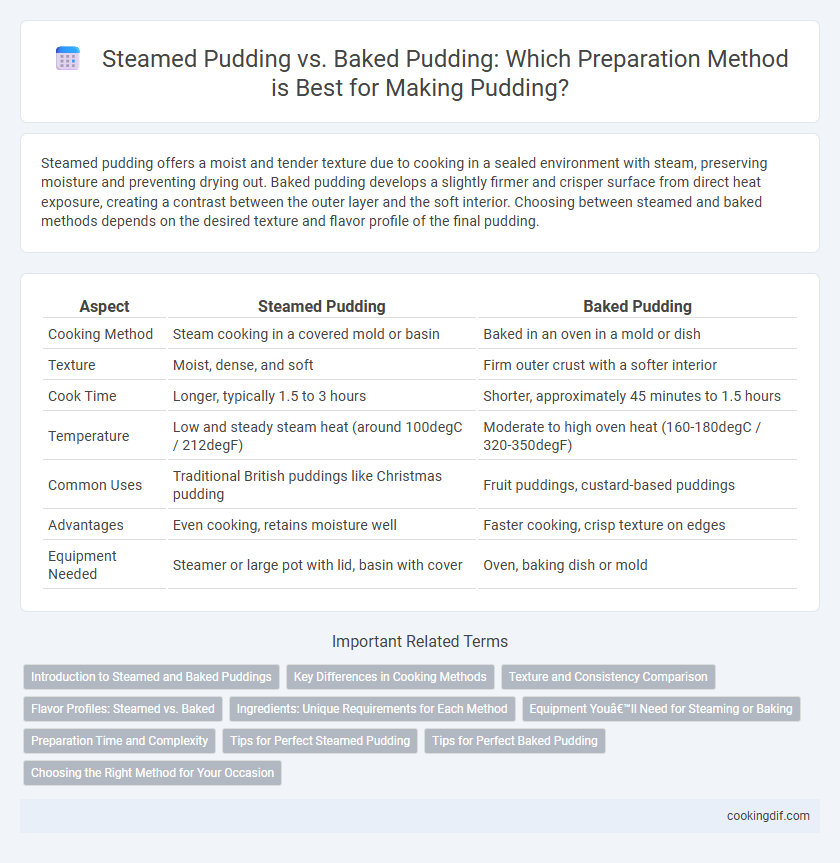Steamed pudding offers a moist and tender texture due to cooking in a sealed environment with steam, preserving moisture and preventing drying out. Baked pudding develops a slightly firmer and crisper surface from direct heat exposure, creating a contrast between the outer layer and the soft interior. Choosing between steamed and baked methods depends on the desired texture and flavor profile of the final pudding.
Table of Comparison
| Aspect | Steamed Pudding | Baked Pudding |
|---|---|---|
| Cooking Method | Steam cooking in a covered mold or basin | Baked in an oven in a mold or dish |
| Texture | Moist, dense, and soft | Firm outer crust with a softer interior |
| Cook Time | Longer, typically 1.5 to 3 hours | Shorter, approximately 45 minutes to 1.5 hours |
| Temperature | Low and steady steam heat (around 100degC / 212degF) | Moderate to high oven heat (160-180degC / 320-350degF) |
| Common Uses | Traditional British puddings like Christmas pudding | Fruit puddings, custard-based puddings |
| Advantages | Even cooking, retains moisture well | Faster cooking, crisp texture on edges |
| Equipment Needed | Steamer or large pot with lid, basin with cover | Oven, baking dish or mold |
Introduction to Steamed and Baked Puddings
Steamed pudding involves cooking a batter or mixture by enclosing it in a mold and placing it in a water bath, resulting in a moist and dense texture that retains rich flavors. Baked pudding, on the other hand, is cooked in an oven without water, producing a firmer, often lighter consistency with a slightly caramelized crust. Both methods highlight different traditional preparation styles, influencing the dessert's texture and flavor profile significantly.
Key Differences in Cooking Methods
Steamed pudding involves cooking the batter in a covered container over boiling water, resulting in a moist and dense texture due to the gentle, indirect heat. Baked pudding is cooked in an oven, where dry heat surrounds the mixture, producing a firmer and often slightly crusted exterior. The choice between steaming and baking significantly influences moisture retention, texture, and overall consistency of the pudding.
Texture and Consistency Comparison
Steamed pudding produces a moist and dense texture due to the gentle, even heat and steam that surrounds the mixture, resulting in a soft and smooth consistency. Baked pudding generally has a firmer and slightly drier texture, with a more structured and sometimes crusty exterior from direct oven heat. Texture differences arise from the cooking environment, where steaming locks in moisture and baking creates a more concentrated, varied consistency.
Flavor Profiles: Steamed vs. Baked
Steamed pudding retains moisture, resulting in a soft, dense texture with subtle, delicate flavors that meld harmoniously. Baked pudding develops a caramelized crust, enhancing richness and adding a toasty, complex flavor dimension. Choosing between steamed and baked methods significantly influences the pudding's aromatic intensity and mouthfeel.
Ingredients: Unique Requirements for Each Method
Steamed pudding requires a batter with higher moisture content and often includes suet or butter to create a dense, moist texture during the gentle steam cooking process. In contrast, baked pudding uses a thicker mixture with leavening agents like baking powder to rise and develop a firmer, cake-like consistency under dry heat. Each method demands precise ingredient ratios to achieve the characteristic texture and flavor profiles unique to steamed versus baked puddings.
Equipment You’ll Need for Steaming or Baking
Preparing steamed pudding requires a heatproof basin or pudding mold, a large pot or steamer with a fitted lid, and kitchen twine to secure the pudding cloth or cover. For baked pudding, the essential equipment includes an oven-safe dish or ramekin with a lid or foil cover to retain moisture during baking. Both methods benefit from using a timer and thermometer to ensure precise cooking times and temperatures for the perfect texture.
Preparation Time and Complexity
Steamed pudding typically requires longer preparation and cooking time, often ranging from 1.5 to 3 hours, due to the slow, moist heat method that ensures a dense, moist texture. Baked pudding generally cooks faster, around 45 minutes to 1 hour, using dry heat which results in a firmer texture but may risk drying out if overbaked. The complexity of steamed pudding preparation is higher, involving careful temperature control and water bath setup, while baked pudding demands less precision and is more beginner-friendly.
Tips for Perfect Steamed Pudding
Steamed pudding requires precise control of steaming time and water temperature to achieve a moist and tender texture, typically around 1.5 to 2 hours of gentle steaming. Using a heatproof bowl tightly covered with foil or a lid prevents condensation from dripping onto the pudding, which helps maintain an even consistency. Ensure the water level is consistently high during steaming to avoid drying out or uneven cooking of the dessert.
Tips for Perfect Baked Pudding
Use a water bath when preparing baked pudding to ensure even heat distribution and prevent the edges from overcooking. Line your baking dish with parchment paper or grease it thoroughly to avoid sticking and achieve a smooth texture. Monitor the baking time closely, inserting a skewer to check for doneness when it comes out clean, ensuring a moist yet fully set pudding.
Choosing the Right Method for Your Occasion
Steamed pudding offers a moist, dense texture ideal for festive gatherings and traditional celebrations, while baked pudding delivers a lighter, more cake-like consistency suited for casual dinners or dessert-focused events. Consider steamed pudding for recipes requiring prolonged cooking times and a rich, custardy finish, whereas baked pudding is preferable when a crispier crust and quicker preparation are desired. Matching the cooking method to the occasion enhances the overall dining experience and highlights the pudding's unique qualities.
Steamed Pudding vs Baked Pudding for preparation Infographic

 cookingdif.com
cookingdif.com